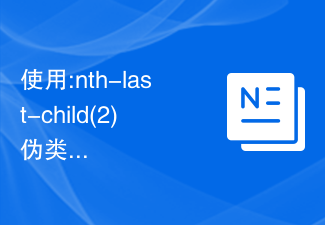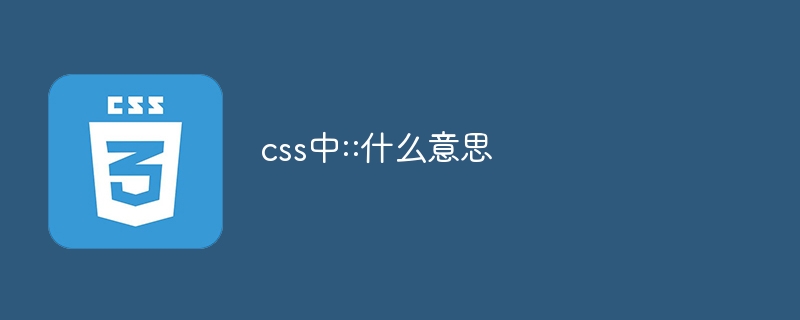本文介紹Css偽類:is和:not,並解釋is、not、matches、any之間的關係

##:not
The :not() CSS pseudo-class represents elements that do not match a list of selectors. Since it prevents specific items from being selected, it is known as the negation pseudo-class.以上是MDN對not的解釋
#推薦學習:##CSS影片教學 單從名字上我們應該能對它有大概的認知,非選擇,排除括號內的其它元素
#最簡單的例子,用CSS將div內,在不改變html的前提下,除了P標籤,其它的字體顏色變成藍色,
<div>
<span>我是蓝色</span>
<p>我是黑色</p>
<h1>我是蓝色</h2>
<h2 id="我是蓝色">我是蓝色</h2>
<h3 id="我是蓝色">我是蓝色</h3>
<h4 id="我是蓝色">我是蓝色</h4>
<h5 id="我是蓝色">我是蓝色</h5>
</div>之前的做法
div span,div h2,div h3, div h4,{
color: blue;
}not寫法
div:not(p){
color: blue;
}從上面的例子可以明顯體會到not偽類選擇器的作用
#下面升級一下,問:將div內除了span和p,其它字體顏色變成藍色
div:not(p):not(span){
color: blue;
}還有更簡潔的方法,如下,但是目前相容不太好,不建議使用
div:not(p,span){
color: blue;
}相容##除IE8,目前所有主流瀏覽器都支援,可以放心使用
:is
The :is() CSS pseudo-class function takes a selector list as its argument, and selects any element that can be selected by one of the selectors in that list. This is useful for writing large selectors in a more compact form.
在說is之前,說is前,需要先了解matchesmatches跟is是什麼關係? matches是is的前世,但是本質上確實一個東西,用法完全一樣matches這個單字意思跟它的作用非常匹配,但是它跟not作用恰好相反,作為not的對立面,matches這個次看起來確實格格不入,而且單字不夠簡潔,所以它被改名了,這裡還有一個issue https://github.com/w3c/csswg-drafts/issues/3258,也就是它改名的源頭好了,現在知道matches和is其實是東西,那麼is的用法是怎麼樣的呢? 範例:將header和main下的p標籤,在滑鼠hover時文字變成藍色#以上是MDN的解釋
<header>
<ul>
<li><p>鼠标放上去变蓝色</p></li>
<li><p>鼠标放上去变蓝色</p></li>
</ul>
<p>正常字体</p>
</header>
<main>
<ul>
<li><p>鼠标放上去变蓝色</p></li>
<li><p>鼠标放上去变蓝色</p></li>
<p>正常字体</p>
</ul>
</main>
<footer>
<ul>
<li><p>正常字体</p></li>
<li><p>正常字体</p></li>
</ul>
</footer>之前的做法header ul p:hover,main ul p:hover{
color: blue;
}is寫法:is(header, main) ul p:hover{
color: blue;
}從上面的例子大概能看出is的左右,但是並沒有完全體現出is的強大之處,但是當選擇的內容變多之後,特別是那種層級較多的,會發現is的寫法有多簡潔,拿MDN的一個例子看下之前的寫法/* Level 0 */
h1 {
font-size: 30px;
}
/* Level 1 */
section h1, article h1, aside h1, nav h1 {
font-size: 25px;
}
/* Level 2 */
section section h1, section article h1, section aside h1, section nav h1,
article section h1, article article h1, article aside h1, article nav h1,
aside section h1, aside article h1, aside aside h1, aside nav h1,
nav section h1, nav article h1, nav aside h1, nav nav h1 {
font-size: 20px;
}is寫法/* Level 0 */
h1 {
font-size: 30px;
}
/* Level 1 */
:is(section, article, aside, nav) h1 {
font-size: 25px;
}
/* Level 2 */
:is(section, article, aside, nav)
:is(section, article, aside, nav) h1 {
font-size: 20px;
}可以看出,隨著嵌套層級的增加,is的優勢越來越明顯說完了is,那就必須認識any,前面說到is是matches的替代者,##any跟is又是什麼關係呢?
是的,is也是any的替代品,它解決了any的一些弊端,例如瀏覽器前綴、選擇效能等any作用跟is完全一樣,唯一不同的是它需要加瀏覽器前綴,用法如下
:-moz-any(.b, .c) {
}
:-webkit-any(.b, .c) {
}結論
透過上面的介紹大概講述了css偽類is,not,matches,any它們三者的關係
is not組合是大勢所趨
本文來自PHP中文網,
CSS教學專欄,歡迎學習
以上是5分鐘讀懂css偽類選擇器:is :not的詳細內容。更多資訊請關注PHP中文網其他相關文章!
 css中hover什么意思Feb 22, 2024 pm 01:24 PM
css中hover什么意思Feb 22, 2024 pm 01:24 PMCSS中的:hover是一种伪类选择器,用于在用户悬停在特定元素上时,应用特定的样式。当鼠标悬停在元素上时,可以通过:hover为其添加不同的样式,从而增强用户体验和交互效果。本文将详细讨论:hover的含义以及给出具体的代码示例。首先,让我们了解一下CSS中:hover的基本用法。在CSS中,可以通过选择器来选中要应用:hover效果的元素,并在其后面加上
 css中的li标签怎么去除前面的圆点Apr 28, 2024 pm 12:36 PM
css中的li标签怎么去除前面的圆点Apr 28, 2024 pm 12:36 PMCSS中去除li标签圆点的方法有两种:1.使用"list-style-type: none;"样式;2.使用透明图片和"list-style-image: url("transparent.png");"样式。两种方法都能删除所有li标签的圆点,如果您只想删除某些li标签的圆点,可以使用伪类选择器。
 如何使用:nth-child(-n+5)伪类选择器选择位置小于等于5的子元素的CSS样式Nov 20, 2023 am 11:52 AM
如何使用:nth-child(-n+5)伪类选择器选择位置小于等于5的子元素的CSS样式Nov 20, 2023 am 11:52 AM如何使用:nth-child(-n+5)伪类选择器选择位置小于等于5的子元素的CSS样式在CSS中,伪类选择器是一种强大的工具,可以通过特定的选择方式来选取HTML文档中的某些元素。其中,:nth-child()是一种常用的伪类选择器,可以选择特定位置的子元素。:nth-child(n)可以匹配HTML中的第n个子元素,而:nth-child(-n)可以匹配
 使用CSS中的content属性Feb 19, 2024 am 10:56 AM
使用CSS中的content属性Feb 19, 2024 am 10:56 AMCSS中content属性的用法CSS中的content属性是一个非常有用的属性,它是用来在伪类中插入额外的内容的。content属性一般只能在伪类选择器(如::before和::after)中使用,它可以用来插入文本或者图片等内容。我们可以通过content属性实现一些非常炫酷的效果。下面是content属性的一些用法以及具体的代码示例:插入文本内容通过
 css中hover怎么使用Feb 23, 2024 pm 12:06 PM
css中hover怎么使用Feb 23, 2024 pm 12:06 PMCSS中的hover伪类是一个非常常用的选择器,它允许我们在鼠标悬停在元素上时改变其样式。本文将为大家介绍hover的用法,并提供具体的代码示例。一、基本用法要使用hover,我们需要先为该元素定义一个样式,然后使用:hover伪类来制定鼠标悬停时对应的样式。例如,我们有一个button元素,当鼠标悬停在按钮上时,我们希望按钮的背景色变为红色,文字颜色变为白
 使用:nth-last-child(2)伪类选择器选择倒数第二个子元素的样式Nov 20, 2023 am 11:22 AM
使用:nth-last-child(2)伪类选择器选择倒数第二个子元素的样式Nov 20, 2023 am 11:22 AM使用:nth-last-child(2)伪类选择器选择倒数第二个子元素的样式,需要具体代码示例在CSS中,伪类选择器是一种非常强大的工具,可以用来选择文档树中特定的元素。其中之一就是:nth-last-child(2)伪类选择器,它可以选择倒数第二个子元素并对其应用样式。首先,让我们来创建一个示例HTML文档,以便我们可以在其中使用这个伪类选择器。以
 不同种类的CSS3选择器Feb 18, 2024 pm 11:02 PM
不同种类的CSS3选择器Feb 18, 2024 pm 11:02 PMCSS3选择器有多种类型,它们可以根据不同的元素属性、结构关系或状态来选择元素。下面将介绍几种常用的CSS3选择器类型,并提供具体的代码示例。基本选择器:元素选择器:使用元素名称作为选择器,此处以p元素为例:p{color:red;}类选择器:使用类名作为选择器,以.开头,此处以class为example的元素为例:.example{fo


熱AI工具

Undresser.AI Undress
人工智慧驅動的應用程序,用於創建逼真的裸體照片

AI Clothes Remover
用於從照片中去除衣服的線上人工智慧工具。

Undress AI Tool
免費脫衣圖片

Clothoff.io
AI脫衣器

AI Hentai Generator
免費產生 AI 無盡。

熱門文章

熱工具

Safe Exam Browser
Safe Exam Browser是一個安全的瀏覽器環境,安全地進行線上考試。該軟體將任何電腦變成一個安全的工作站。它控制對任何實用工具的訪問,並防止學生使用未經授權的資源。

DVWA
Damn Vulnerable Web App (DVWA) 是一個PHP/MySQL的Web應用程序,非常容易受到攻擊。它的主要目標是成為安全專業人員在合法環境中測試自己的技能和工具的輔助工具,幫助Web開發人員更好地理解保護網路應用程式的過程,並幫助教師/學生在課堂環境中教授/學習Web應用程式安全性。 DVWA的目標是透過簡單直接的介面練習一些最常見的Web漏洞,難度各不相同。請注意,該軟體中

SublimeText3 英文版
推薦:為Win版本,支援程式碼提示!

EditPlus 中文破解版
體積小,語法高亮,不支援程式碼提示功能

SublimeText3 Linux新版
SublimeText3 Linux最新版







